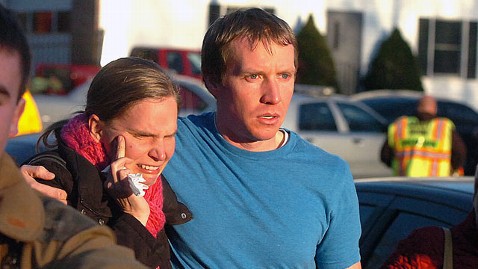
(Courtesy Ronald Reagan Library, Michael Evans)
“In 1982, Ronald Reagan sat down with the Democrats and they had a deal—a $3 cut in spending for every dollar they raised in taxes. Guess what? They raised the taxes, and they never cut the spending.”
--oft-repeated story told in Washington during “fiscal cliff” negotiations
It had become an article of faith by conservatives that President Reagan reluctantly agreed to raise taxes in his first term in office — and that Congress then failed to follow though on promised spending cuts. The frequent recitation of this story during the current fiscal debate made us wonder: What actually happened three decades ago?
It’s not hard to find the source of this story — Reagan’s own memoir, “An American Life.” Here’s what he wrote: “I made a deal with the congressional Democrats in 1982, agreeing to support a limited loophole-closing tax increase to raise more than $98.3 billion over three years in return for their agreement to cut spending by $280 billion during the same period; later the Democrats reneged on their pledge and we never got those cuts.”
When Reagan made a nationally-televised speech in support of the tax hike — trying to refute charges that it was the biggest tax increase in U.S. history — he also cited a 3:1 agreement:
“Revenues would increase over a 3-year period by about $99 billion, and outlays in that same period would be reduced by $280 billion. Now, as you can see, that figures out to about a 3-to-1 ratio -- $3 less in spending outlays for each $1 of increased revenue. This compromise adds up to a total over 3 years of a $380 billion reduction in the budget deficits.”
The Washington Post did not have a Fact Checker column back then, and this speech certainly would have been ripe for fact checking. (We would have been suspicious of his use of the word “outlays.”) Let’s go back in time to show what really happened, using documents, news reports and memoirs of the period.
The Facts
Despite Reagan’s claim that he made a deal with the Democrats, the Senate at the time was controlled by Republicans. Sen. Bob Dole of Kansas — then chairman of the Finance Committee and later the majority leader and Republican nominee for president — was a driving force behind a big tax increase because he was concerned about soaring deficits after Reagan had boosted defense spending and slashed taxes.
Dole warned the White House that the final year of Reagan’s three-year tax cut was at risk unless revenue could be raised in other ways. Under Dole’s leadership, the Senate Finance Committee led the way in crafting a big tax bill, fending off efforts by Democrats to halt Reagan’s tax cut.
Key people on Reagan’s team — especially budget director David Stockman and White House chief of staff James A. Baker III — were eager to rein in the deficit. But others, such a Treasury Secretary Donald Regan, were skeptical of a deal. Regan, in his memoir “For the Record,” proudly notes that he demanded a ratio of $1 in tax increases for $3 in spending cuts.
Stockman, in an interview, acknowledged that “we needed a three-to-one ratio to get the deal accepted by Reagan and the Adam Smith tie boys (e.g. Ed Meese, et al).” But it appears that Reagan and Regan did not actually understand the mechanics of the agreement. It turns out that much of the savings were not from spending cuts — and many of the savings were dependent on actions by the Reagan administration.
Here’s the actual breakdown of the three-year agreement, according to a June 1982 chart prepared by the GOP-controlled Senate Budget Committee staff, which appears in the 1989 book “The Deficit and the Public Interest,” by Joseph White and Aaron B. Wildavsky. (Note: The numbers represent reductions from anticipated, inflation-adjusted outlays.)
Revenues: $98.3 billion (26 percent)
Defense cuts: $26.4 billion (7 percent)
Nondefense cuts: $34.8 billion (9.1 percent)
Entitlement cuts: $30.8 billion (8.1 percent)
Other reductions/offsets: $7.8 billion (2 percent)
Freeze federal pay raise: $26.1 billion (6.9 percent)
Management savings: $46.6 billion (12.3 percent)
Net interest: $107.7 billion (28.4 percent)
Total non-revenue: $280.2 billion (74 percent)
Total: $378.5 billion
We will never know if Reagan saw this specific breakdown. On the surface, one could plausibly believe there was a ratio of 3:1 in terms of lower outlays to higher taxes, as Reagan put it in his speech. But a reduction in “outlays” is not the same as cutting spending on programs.
Indeed, almost half of the “cuts,” such as interest savings on debt (from lower interest costs and reduced deficits) and “management savings,” were beyond the control of Congress. At best, the spending savings that Congress could deliver, including defense cuts, amounted to a 1:1 ratio.
Congress passed $30 billion in spending cuts (mostly on entitlement programs) at the same time as the tax bill, according to news reports; The Washington Post described the twin congressional actions as “enormous bills by historical standards.” Lawmakers then struggled much of the next year to cut spending even more. But news reports also show the administration repeatedly failed to deliver on its side of the spending-cut bargain.
Stockman says the $46 billion in management savings “was just a made-up target that never really had any content” in order to reach the 3:1 ratio. Meanwhile, Defense Secretary Caspar Weinberger simply refused to comply with the agreement, and so Reagan’s future budgets ignored the requirements for proposing defense cuts. Stockman says that the entitlement cuts—mainly price controls on Medicare billing—were implemented but “got lost in higher than expected Medicare inflation.”
“In essence, the funny numbers, meant to impress voters and maybe the markets, fooled the president. They also fooled Donald Regan and Ed Meese,” write White and Wildavsky. “To Stockman, Baker, [Richard] Darman and congressional leaders, this sense of betrayal was ludicrous; no one ever said Congress would pass three-for-one. The [congressional budget] resolution was clear enough about that.”
Stockman, in his memoir, “The Triumph of Politics,” blames the late Rep. Jack Kemp (R-N.Y.) — later Dole’s vice presidential running mate — for convincing Reagan that he had been “hornswoggled” by Congress. By Stockman’s accounting, Congress did reasonably well in meeting the terms of the deal, but the administration had failed to live up to its end of the bargain. “Reagan did get tricked — mainly by Weinberger and his own Cabinet,” Stockman said this week.
Dole felt compelled to send Reagan a letter on Jan. 16, 1984, clarifying what had actually happened:
The most frequently voiced objections to packaging new spending cuts and revenue increases together is that Congress would enact the new taxes but renege on the spending cuts. These critics cite as evidence the alleged failure of Congress in 1982 to deliver any of the promised three dollars in spending cuts for each dollar of tax increase. I respectfully submit, Mr. President, that you were not “taken in” by this budget plan.
In fact, historical budget data shows that Congress did reduce spending. From 1982 to 1983, nondefense discretionary spending fell from 4.3 percent to 4.2 percent of the overall economy (gross domestic product) — and then kept falling until it reached 3.4 percent of GDP in 1989. Defense spending kept going up until 1986.
The Pinocchio Test
It is time to abandon this myth. Reagan may have convinced himself he had been snookered, but that belief is based on a fundamental misunderstanding of the deal he had reached.
Congress was never expected to match the tax increases with spending cuts on a 3:1 basis. Reagan appeared to acknowledge this in his speech when he referred to outlays (which would include interest expenses), rather than spending cuts. In the end, lawmakers apparently did a better job of living up to the bargain than the administration did.
If people want to cite the lessons of history, they need to get the history right in the first place.
Four Pinocchios

(About our rating scale)
Check out our candidate Pinocchio Tracker
Follow The Fact Checker on Twitter and friend us on Facebook
.















